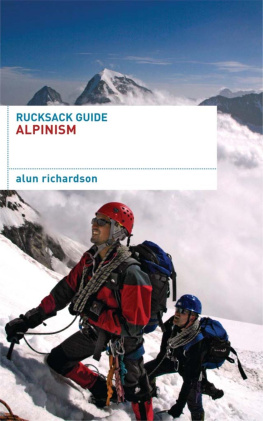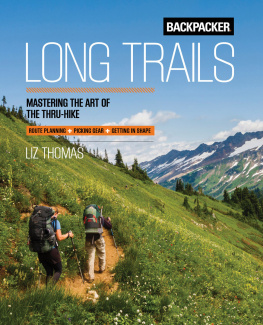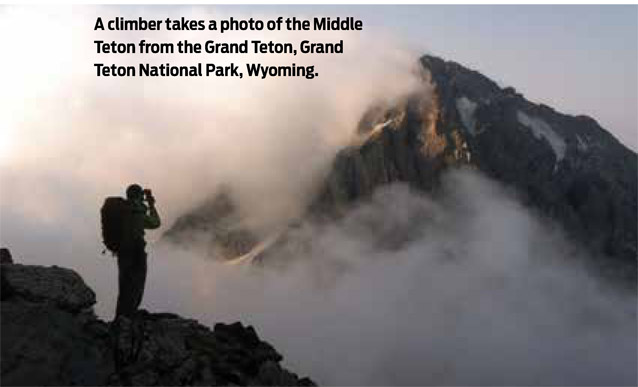About the Author
Brendan Leonard is the creator of Semi-Rad.com, a climber, and a writer. He is a contributing editor at Climbing, Adventure Journal, and The Dirtbag Diaries, and his writing has appeared in Backpacker, National Geographic Adventure, High Country News, Mens Journal, Outside, Adventure Cyclist, and other publications. He is the author of The New American Road Trip Mixtape (2013), Funny Shit in the Woods: The Best of Semi-Rad.com (2014), and coauthor of Classic Front Range Trad Climbs (2015). He lives in Denver, Colorado.
ABOUT THIS BOOK
All who are drawn to the mountains find their own way to acquire the knowledge they need to stay safe and find success up high. I got lucky early on and met a few people who could teach me things about gear, weather, how to move on rock and snow, and, most important, how to be smart and safe about it.
This book is intended to introduce newcomers to the mountains, as well as provide a reference for more experienced hikers. Theres a mountaineers adage that has a few variations and has been attributed to several famous climbers (including Ed Viesturs, the first American to summit all fourteen 8,000-meter peaks), and it goes something like Summiting is optionalcoming home is mandatory.
This book will give you the tools to make it to the summitand to know when to turn around and save a peak for another day.
Acknowledgments
My friend Tim McCall led me up Borah Peak in 2003, and the following fall when I told him I was working on my masters thesis at the University of Montana, he asked, Whats it on, peak bagging? It wasnt, but I switched it to focus on peak bagging, and that may have made all the difference in my career. Tim accompanied me on every hike I wanted to do in the Missoula area that fall, including a hike up Grave Peak that we didnt finish until eight years later. I cant thank Tim enough for being a good friend during my two years in Montana, and for putting up with me when I knew absolutely nothing about the outdoors.
Outdoor Research has sponsored my adventures in the outdoors since 2011 and sponsored my writings at Semi-Rad.com since 2013. Ive never been let down by their gear and apparel.
Ive shared summits with dozens of friends and family members over the years and am grateful to have such amazing people in my life who want to have conversations while huffing and puffing up trails instead of sitting on a barstool.
Appendix A: Packing Lists
Day Hikes
Synthetic base layers
Pants or shorts
Socks
Shoes or boots
Gaiters (optional)
Rain jacket
Rain pants (optional)
Soft shell jacket
Puffy jacket (optional)
Sunhat (optional)
Beanie
Lightweight gloves
Trekking poles
Water bottles or hydration reservoir
Knife
Headlamp
First-aid kit
Navigation (map and compass and/or GPS)
Emergency kit
Water treatment items (optional)
Sunscreen
Personal locator beacon or satellite messenger (optional)
Ice ax (depending on climb)
Crampons (depending on climb)
Helmet (depending on climb)
Overnight Hikes
Sleeping:
Tent or tarp
Sleeping bag
Sleeping pad
Pillow (optional)
Headlamp
Kitchen:
Stove
Fuel
Lighter and/or matches
Pot or cook set
Spoon or spork
Bowl
Cup
Pocketknife and/or multitool
Bear canister or bear hang bag
Hydration:
Water bottles
Water treatment device or halogens
Food:
Dinner
Breakfast
Coffee
Snacks
Personal care:
Toiletries
Earplugs
Sunscreen
Insect repellent
Trowel for human waste disposal
Hand sanitizer
First-aid kit
Small repair kit (needle and thread, duct tape, patches for tent/sleeping pad)
Map and compass or GPS
Appendix B: Internet Resources
Backpacker.com
Backpacking gear reviews, outdoor skills information and advice, and destinations for backpacking, camping, and hiking.
SummitPost.org
User-submitted information and trip reports on peaks throughout the US and the world.
14ers.com
User-submitted information and trip reports on Colorados 14,000-foot peaks.
13ers.com
A companion site to 14ers.com, covering Colorados 13,000-foot peaks.
HighPointers.org
Official website of the Highpointers Club, a group focusing on climbing the high points of each of the fifty states.
HikeAZ.com
User-submitted information and trip reports for Arizona hikes; includes dozens of peaks.
EveryTrail.com
User-submitted information for trails around the US.
CNYHiking.com
Website containing exhaustive information on hiking in New York.
Adkforum.com
Forum containing hiking information and trip reports for the Adirondack Mountains.
Vftt.org
Forum with user-submitted trip reports and trail conditions for all Northeast states.
SectionHiker.com
Philip Werners personal site with exhaustive information on hiking the New Hampshire 4,000-foot peaks.
Outdoors.org
Appalachian Mountain Clubs site, containing information on hiking the New Hampshire 4,000-footers.
IdahoSummits.com
Dan Robbinss personal site with information about peaks in the western US.
Chapter One Introduction to Peak Bagging
In the hiking world, the term peak bagger has sometimes been used to describe someone whose outdoor exploration is motivated by summitsand, maybe in some cases a little unflatteringly, for people who have some form of summit fever. Ive always liked it and respected and admired many of the people I might consider peak baggers. I see them as self-motivated, people who arent afraid to write down, or at least verbalize, their goals.
There are the folks who set out to climb all the Adirondack 46ers, all the White Mountains 4000ers, all the Colorado 14ers, or all the Colorado Centennial Peaks (the one hundred highest in the state) or join the Highpointers Club, whose members aim for all fifty state high points, from Alaskas 20,320-foot Denali all the way down to Floridas 340-foot Britton Hill, or the County Highpointers, who try to tag as many of Americas 3,191 county high points as they can, from peaks in the Rocky Mountains to a particular surveyed spot on a golf course in New York City. I say if a list of summits gets you into the outdoors, more power to youyoure lucky to have found something that ignites passion in you. Some of the best views in the world are from the tops of mountainseven better if, during the climbs to the tops of those mountains, you remember to stop and look around every once in a while.

Finding your way to a summit is one of the great joys of the outdoors, and its important to know how to do it safely. As beautiful as the mountains are, they are completely indifferent to your success and your personal well-being. Theres no lift to the top, no ski patrol to call if you get lost, and no chalets where you can head inside and get a cup of hot chocolate when you get cold. The most important thing you should know about mountains is that they can kill youeven if youre just out for a day hike. Dozens of people have lost their lives on New Hampshires Mount Washington when the weather changed suddenly and they were caught unprepared. Mount Washington is only 6,288 feet tall and has a paved road that goes all the way to the summit, yet it is one of the deadliest mountains in America because of something thats easy to forget when you start out at the parking lot and its sunny and warm: the weather.













